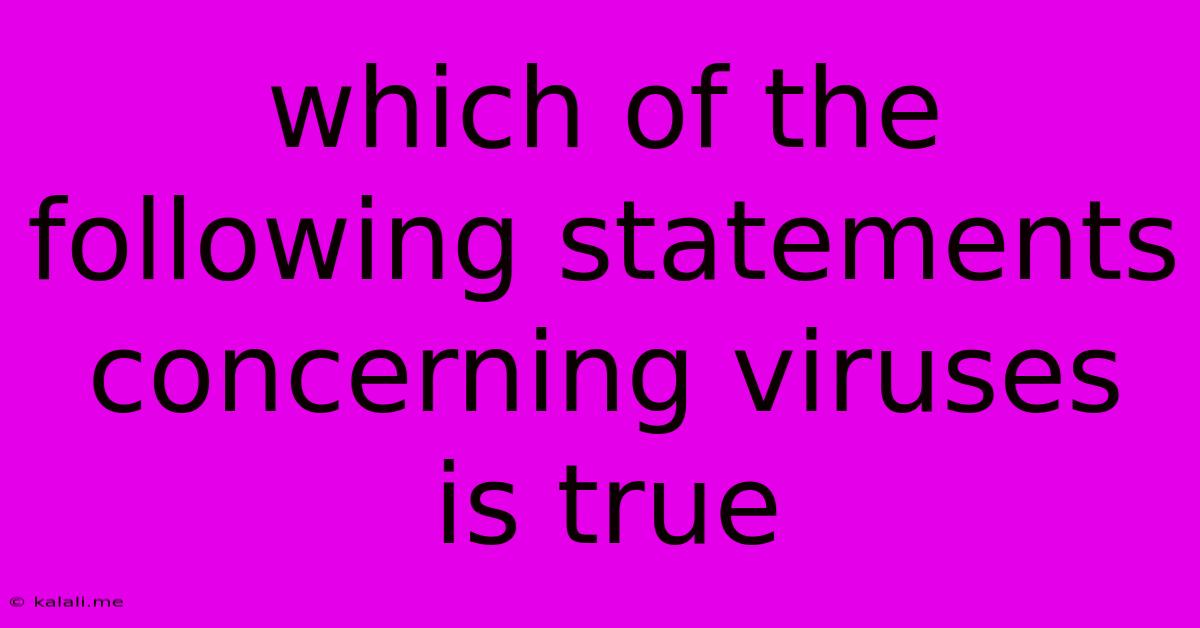Which Of The Following Statements Concerning Viruses Is True
Kalali
Jun 14, 2025 · 3 min read

Table of Contents
Which of the Following Statements Concerning Viruses is True? A Deep Dive into Virology
Viruses. Tiny, often invisible agents of infection, they're responsible for everything from the common cold to devastating global pandemics. Understanding their nature is crucial, and that begins with clarifying common misconceptions. This article will explore several statements about viruses and determine which one rings true, delving into the fascinating complexities of virology along the way.
Meta Description: Decipher the truth about viruses! This article explores common statements regarding viral structure, replication, and impact, separating fact from fiction in the world of virology.
Many statements about viruses circulate, often conflicting. Let's examine some common claims and determine their veracity:
Statement 1: Viruses are always harmful to their hosts.
False. While many viruses cause disease (pathogenic viruses), a significant number exist in a symbiotic or commensal relationship with their hosts. These viruses don't cause harm and can even benefit their host in some cases. Bacteriophages, viruses that infect bacteria, are frequently used in research and potentially in therapeutic applications, highlighting their diverse roles beyond simple pathogenicity. The relationship between a virus and its host is complex and depends on various factors.
Statement 2: Viruses are living organisms.
False. This is a frequent point of contention. Viruses lack the fundamental characteristics of life as we generally understand it. They cannot reproduce independently; they require a host cell's machinery to replicate. They don't maintain homeostasis, nor do they exhibit independent metabolism. While they evolve and adapt, exhibiting some properties associated with life, the lack of independent reproduction and metabolism places them outside the generally accepted definition of a living organism. They occupy a fascinating gray area in the biological world. The debate over their classification is ongoing within the scientific community.
Statement 3: Viruses are composed solely of DNA or RNA.
False. While viral genomes consist primarily of either DNA or RNA, viruses also possess a protein coat, known as a capsid, which protects the genetic material. Some viruses also have an additional lipid envelope derived from the host cell membrane. Therefore, viruses are not solely composed of genetic material; they are complex entities with protein and sometimes lipid components. The capsid's structure and the presence or absence of an envelope are key factors in viral classification and infectivity.
Statement 4: Viruses can be treated with antibiotics.
False. Antibiotics target bacterial processes. Because viruses lack their own metabolic machinery and rely on the host cell, antibiotics are ineffective against them. Antiviral medications target specific viral processes, such as reverse transcriptase in retroviruses or neuraminidase in influenza viruses, offering a different mechanism of action. The development of effective antiviral drugs is an ongoing area of significant research, given the ever-evolving nature of viruses.
Statement 5: Viruses are acellular.
True. This is the correct statement. Acellular means "lacking cells." Viruses are not made up of cells; they are simpler entities composed of genetic material (DNA or RNA) and a protein coat. This fundamental characteristic distinguishes them from bacteria, fungi, protists, and other cellular organisms. Their acellular nature contributes to their ability to exploit host cellular machinery for replication.
In conclusion: The statement "Viruses are acellular" is the only true statement among those presented. Understanding the complexities of viruses—their structure, life cycle, and interactions with their hosts—is vital for developing effective preventative measures and treatments for viral diseases. The ongoing research in virology continuously reveals new insights into this fascinating and ever-evolving field of study.
Latest Posts
Latest Posts
-
A Store Sells Two Different Sized Containers Of Blueberries
Jun 14, 2025
-
Which Trophic Level Contains The Most Energy
Jun 14, 2025
-
What Is The Smallest Particle In Soil
Jun 14, 2025
-
Least Common Multiple Of 18 And 36
Jun 14, 2025
-
Diego One Of Two Joint Winners
Jun 14, 2025
Related Post
Thank you for visiting our website which covers about Which Of The Following Statements Concerning Viruses Is True . We hope the information provided has been useful to you. Feel free to contact us if you have any questions or need further assistance. See you next time and don't miss to bookmark.